Bagley Farms Meat Market Edwardsville IL: Your Trusted Source for High-Quality Meats
Bagley Farms Meat Market Edwardsville IL: Your Trusted Source for High-Quality Meats
Blog Article
Discover the Finest Choice of Cuts From Regional Meat Market
In an era where the origins of our food are more significant than ever, exploring the finest selection of cuts from your local meat market provides a compelling story of top quality and honesty. These markets not just guarantee exceptional freshness and taste yet additionally supply insights into the subtleties of different primitive and sub-primal cuts.
Advantages of Regional Meat Markets
Regional meat markets provide countless benefits that are becoming progressively significant in today's food landscape. Since the supply chain is shorter, regional meat does not endure prolonged transport times, protecting its quality and nutritional worth.
Additionally, local meat markets usually support lasting farming practices. Lots of local producers participate in eco-friendly and ethical farming techniques, which add to the well-being of animals and the preservation of natural resources. By picking to purchase from these markets, consumers can contribute in promoting sustainable farming and reducing their carbon impact.
In addition, local meat markets add to the financial vigor of communities. By supporting neighborhood manufacturers, consumers assist endure tiny organizations and foster financial growth within their region. This economic support can cause job development and help preserve the special personality of local areas.
Comprehending Various Meat Cuts
A fundamental facet of making enlightened buying decisions at local meat markets is understanding the numerous cuts of meat readily available. Largely, meat is classified into primal, sub-primal, and retail cuts.
For instance, from the beef primal cut, the loin, one can obtain sub-primal cuts like tenderloin, resulting in retail choices such as filet mignon. The rib primitive cut includes sub-primal ribs, producing retail selections like ribeye steaks. Recognizing these differences help in choosing cuts that align with cooking demands and personal choices
Moreover, cuts differ in inflammation and fat material, affecting their optimal cooking techniques. Harder cuts like brisket gain from slow-moving cooking, while tender cuts like sirloin are matched for grilling. By realizing these nuances, consumers can enhance their culinary experiences and maximize their meat purchases.

Expert Tips for Picking Meat
Choosing the optimal cut of meat needs not only expertise of the different alternatives readily available but additionally a keen understanding of high quality indications that specialists make use of to make their selections. To start with, focus must be put on the color of the meat. Vivid, abundant tones usually mirror quality, while boring or grayish tones may indicate aging or inappropriate storage space. Next, think about marbling, the fine touches of fat within the muscular tissue. A well-marbled cut commonly guarantees improved taste and inflammation, as the fat melts during food preparation, enhancing the meat's texture and taste.
Another essential element is the meat's texture. It must feel strong yet somewhat generating to the touch, suggesting correct muscle mass integrity. In addition, a clean, fresh aroma is critical; any kind of off or sour odors suggest perishing and ought to be stayed clear of. Expert recommendations additionally entails checking out the packaging, if suitable. Vacuum-sealed or snugly covered packages help maintain freshness and stop contamination.

Last but not least, recognizing the online reputation and sourcing practices of your local meat company can use insights into the high quality and honest requirements of the meat. Involving with experienced butchers can give beneficial referrals customized to details cooking requirements, view making sure a remarkable eating experience.
Finest Seasonal Choices

Picking seasonal cuts not only ensures freshness but additionally straightens with the peak top quality of different meats. Pork, traditionally healed and maintained in the chillier months, supplies a rich selection of cuts like pork and bacon during winter, when pigs are slaughtered after being plumped on autumn harvests. Chicken, on the various other hand, is often at its ideal throughout late springtime and very early summer, when chickens have actually matured on a diet of fresh grains and eco-friendlies.
Sustaining Lasting Practices
Embracing sustainable techniques in meat production is essential for promoting ecological health and making certain the long life of local environments. In the context of neighborhood meat markets, sustainability involves a commitment to ethical farming techniques, these details reducing carbon impacts, and supporting biodiversity. By focusing on these techniques, manufacturers not only enhance the quality of their offerings however additionally add positively to their areas and the planet.
Regional meat markets play an essential role in cultivating sustainable agriculture by sourcing products from farms that carry out green approaches. These might include rotational grazing, natural feed, and incorporated pest monitoring, which collectively lower ecological impact and promote animal welfare. By picking to support such markets, customers can straight affect the demand for sustainably elevated meat, urging even more manufacturers to embrace these techniques.
In addition, lasting techniques in meat manufacturing can dramatically minimize the industry's environmental footprint. Reducing resource use and waste generation through innovative farming methods can lead to substantial decreases in greenhouse gas emissions. This is crucial in dealing with environment change and preserving natural sources for future generations. As a result, sustaining lasting techniques not only benefits the environment yet additionally aligns with a broader dedication to liable consumption and manufacturing.
Verdict
Local meat markets supply unrivaled advantages in regards to top quality, quality, and sustainability. By offering a varied variety of primal and sub-primal cuts, these markets deal with diverse cooking preferences while ensuring openness in sourcing. Seasonal options, such as springtime lamb and autumn beef, enhance the cooking experience with unique flavors and inflammation. Supporting local meat markets like it not just promotes sustainable farming methods but also contributes to a much more informed and enjoyable cooking trip.
Report this page